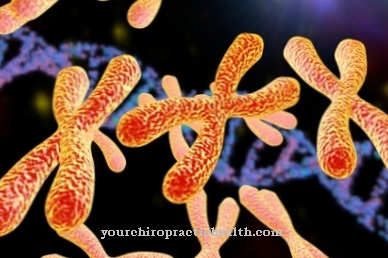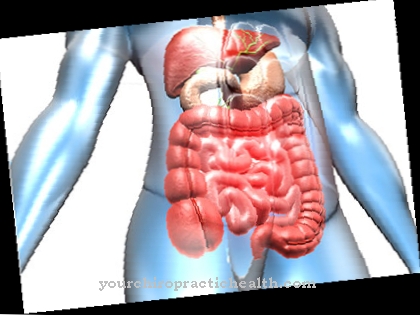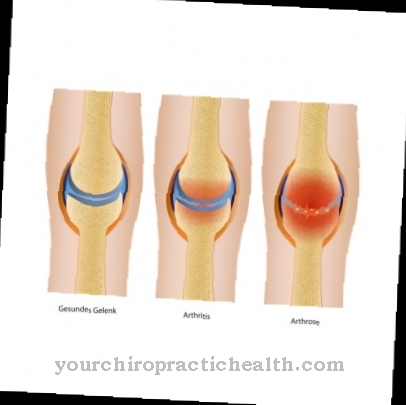A multiple pterygium syndrome occurs in patients with numerous airstrip-like folds of the mucous membrane or skin. Several forms are distinguished. A causal therapy does not yet exist.
What is Multiple Pterygium Syndrome?

© ktsdesign - stock.adobe.com
“Pterygium” literally means “wing skin”. This medical term is a physical abnormality that shows up through folds of skin and mucous membranes similar to those of the skin. Most often, the skin folds are on the side of the neck between the mastoid process and the highest portion of the shoulder blade.
In this localization one also speaks of pterygium colli. The pterygium can be a symptom of a general clinical picture. This is the case, for example, in the context of Ullrich-Turner syndrome. At the multiple pterygium syndrome there are several pterygias at the same time. This syndrome comes in different forms.
In addition to an autosomal recessive form, medicine knows a popliteal and an autosomal dominant form. In addition, there is a type of Frias, a lethal type and an X-linked type of the syndrome. A multiple pterygium syndrome can be associated with completely different symptoms and accordingly have a wide variety of courses.
The prevalence of the individual types differs. Essentially all types of the syndrome correspond to rather rare diseases, of which an average of around one in a million is affected.
causes
Multiple pterygium syndrome always has a genetic basis. This means that internal factors within the DNA are responsible for the transmission of the disease. The transmission differs for the different types of the syndrome.Various inheritance patterns are now associated with the syndrome.
In addition to an autosomal recessive and an X-linked recessive inheritance, an autosomal dominant inheritance is also possible. Apparently, genetic defects play a major role in the disease. These defects can be in different genes and correspond to different types of mutation.
When mutating, the genetic material changes in a specific location. This change in the genetic material results in an anomaly in the assigned gene products. The individual gene products no longer have their physiologically intended form.
As a result of this loss of shape, they also lose their intended function. The result is functional defects that manifest themselves in the form of malformations. What is inherited is the respective mutation with all associated malformations. For the popliteal form, for example, the mutation is on the IRF6 gene at locus 1q32.2.
Symptoms, ailments & signs
As different as the type of mutation, the symptoms of patients with multiple pterygium syndrome can be just as different. In the autosomal recessive type, the syndrome manifests itself primarily through facial malformations with downward eyelid axes, prominent nasal roots, deep neck hairline and narrow ear canal.
Short stature and hearing loss are other symptoms. In this type, pterygias appear on the neck, armpits, fingers or between the chin and chest. There may also be clubfoot with toes grown together. The spine often has vertebral malformations and is crooked (scoliosis).
Rib anomalies and genital malformations are also common. The popliteal form of the syndrome, on the other hand, has multiple wing skin in the hollows of the knees. Clogged eyelid clefts as well as cleft lip and palate and syndactylia are common accompanying symptoms of this type. In the Frias type there is usually no short stature.
In most cases, the lethal form of the syndrome shows pterygia, which limits mobility. In addition, malformations of the skull, neck, face as well as the genitals and vertebral bodies can often be observed in patients with fatal types.
Diagnosis & course of disease
The diagnosis of multiple pterygium syndrome is usually made by the doctor immediately after the birth. Usually the suspected diagnosis is purely visual. The patient's characteristic wing skin is an extremely specific phenomenon and at first glance gives solid indications of the disease.
The classification of course and severity can often not be done by visual diagnosis, but requires more extensive diagnostics with specific examinations such as imaging. The prognosis of the patient depends in detail on the symptoms and their severity. In addition to lethal forms, there are also known forms without direct impairment of life expectancy.
Complications
The pterygium syndrome causes various malformations on the patient's face. These malformations can significantly reduce the aesthetics of the person affected and thus lead to a reduced self-esteem or to inferiority complexes and depression. In addition, it is not uncommon for hearing problems to occur, so that in the worst case scenario, complete hearing loss can also occur.
The pterygium syndrome significantly reduces the quality of life of those affected. A so-called cleft palate also develops. The mobility of the patient can also be restricted and reduced in many cases. The malformations can also affect the neck or the skull. It is not uncommon for the genitals to be affected by the pterygium syndrome, so that there may be restrictions in sexual intercourse.
The treatment of pterygium syndrome is carried out through surgical interventions. With this, most complaints and malformations can be limited relatively well. There are usually no particular complications with these treatments. In many cases, however, psychological treatment is also necessary to prevent or treat depression. However, the life expectancy of the patient is not influenced by the pterygium syndrome.
When should you go to the doctor?
If symptoms such as short stature or hearing loss are noticed, a doctor is needed. Affected people are usually examined shortly after birth, which enables the disease to be clearly diagnosed. In the case of mild syndromes, however, diagnosis can only be made later. The patients then usually consult the doctor due to unspecific complaints, for example due to a cleft lip and palate or a restriction in mobility. Furthermore, a doctor should be consulted if the symptoms worsen or complications arise during treatment.
Multiple pterygium syndrome is treated by your family doctor or an internist. Various specialists can also be called in to treat the individual symptoms. So you have to go to an orthopedic surgeon with a clubfoot, while malformations of the genitals are examined by a proctologist, urologist or gynecologist and treated if necessary. Since the disease is associated with psychological complaints in the vast majority of cases, the doctor responsible will usually suggest therapeutic advice.
Treatment & Therapy
A causal therapy is not yet available for patients with multiple pterygium syndrome. Causal forms of therapy start at the cause. The elimination of the trigger leads in the course of a causal therapy to absolute and permanent freedom from symptoms.
Since the cause of the syndrome is a genetic mutation, a causal treatment of the disease would have to start with the genes. However, gene therapy approaches have not yet reached the clinical phase. Nonetheless, over the past decade, scientists have made advances in gene therapy that could potentially provide causal therapy for genetic mutations in the future.
Since this stage has not yet been reached, patients with multiple pterygium syndrome have so far been treated purely symptomatically and supportively. The focus of symptomatic treatment is the surgical removal of all life-threatening malformations. Severe rib malformations, for example, can constrict the lungs and heart and in this case must be widened through invasive interventions.
Scoliosis, in turn, can reach degrees of severity that severely impair the quality of life. To improve the quality of life, the appearance is often treated with a corset construction. Basically, the therapy depends heavily on the symptoms in the individual case. Psychotherapeutic care is often available to patients and relatives on the part of supportive measures.
You can find your medication here
➔ Medicines against redness and eczemaOutlook & forecast
The cause of multiple pterygium syndrome lies in the human genome. The causal triggers of the disease cannot be eliminated according to the current medical status. It remains to be seen to what extent science will make progress in the foreseeable future. The multiple pterygium syndrome always leads to a reduction in quality of life.
Malformations sometimes have to be corrected with surgical interventions, whereby the results are not always satisfactory. Symptoms are not uncommon throughout life. Outpatient therapy measures and aids are to be used continuously. Multiple pterygium syndrome is very rare. Researchers find it in one in a million people. The severe malformations are usually associated with a significantly shortened lifespan. The extent of the signs plays an important role. Doctors also make an important contribution to survival when they receive organs.
In some cases, sick children do not even reach childhood or adolescence. If patients forego treatment, the malformations usually have such a negative impact that death occurs after a while. Parents in particular often suffer from the psychologically stressful situation.
prevention
The multiple pterygium syndrome can so far only be prevented with fine ultrasound. The malformations are often detectable in the fine ultrasound in the early stages of pregnancy. Couples may decide to terminate the pregnancy based on the findings.
Aftercare
Since multiple pterygium syndrome is a genetically predisposed disease, there is hardly any possibility of follow-up care. Only symptomatic therapies for the disease are provided to make the life of newborns easier. In addition, massages or relaxation techniques can be applied to the person concerned by parents or relatives.
Sound and smell therapies can also provide pain relief in newborns. The newborns should participate in activities and be presented with objects and nursery rhymes. Because not all areas in the brain are affected by the disease, these activities can help the affected child despite the serious illness. The most important thing about aftercare, however, is the physical and psychological well-being of parents and loved ones.
The disease is very stressful and can therefore lead to severe psychological disorders for relatives. The well-being of the family members should therefore be just as important as the seriously ill child. This significantly improves the quality of life of the newborn. The family can offer the affected child an eventful rest of life and be a real support. There are no other options for follow-up care for multiple pterygium syndrome.
You can do that yourself
Since multiple pterygium syndrome is a genetic disease, there are hardly any opportunities for self-help. This can only consist of symptomatic therapies. These include measures to improve the newborn's quality of life.
In addition to medical treatments, these can consist of massages and relaxation techniques that can be used by parents and relatives. Other alternative methods such as olfactory and sound therapies can also be used to relieve pain and stimulate the toddler. Children's activities and objects such as toys and children's songs are perceived and processed by the newborns. As not all brain areas are affected by the disease, such treatments can benefit the children despite the serious illness.
When caring for sick children, however, it is also important for parents and relatives to take care of themselves. The extreme stressful situation that the serious illness of newborns represents can create extreme physical and psychological stress for the family. Therefore, when it comes to self-help, the focus should always be on the well-being of the caring relatives. Only in this way can they provide support and make the child's lifetime as beautiful as possible.


.jpg)

.jpg)












.jpg)







.jpg)


